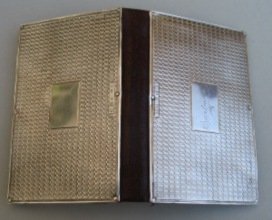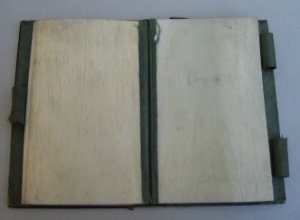|
|
DANCE CARD
Dance cards became popular items at balls and assemblies in
the early 19th century when the more formal balls used in the
previous century were abandoned.
The minuets, danced one couple at a time in a rigidly prescribed
order defined by the social rank of the dancers, gave way
entirely to less formal dances as quadrilles and dances done
with a single partner, like the waltz and the polka.
In the new social context the 'Dance cards' ('carnet de bal' in
French) were used by ladies to keep track of the gentleman to
whom they had promised dances in the course of the evening.
The ladies participated in the ball with their personal 'Dance
card' contained into an elaborate cover of bone, silver or ivory,
often with miniature petit point canvas inserts.
They were small enough to be readily portable and, together with
the
'posy holder' (tussie mussie),
were an indispensable complement to a lady's accessorizing.
|

Personal 'Dance cards' were less common at the end of the 19th
century when a simple card or a card folded in half were
prepared by the 'dance committee', reporting the description of
the occasion for the event, the location and the date.
The interior of the 'dance card' usually contained a list of the
evening's dances, with spaces provided for the names of the
gentlemen to whom the lady had promised them. Covers were
especially colorful and elaborate and afterwards served as
mementos of the occasion.
This one is an ancient leather and silk 'dance card holder' with
silver 'guilloché' covers, made in 1835 by Birmingham's
silversmith Joseph Wilmore. According to Jackson's he entered
his mark in the register between 1803 and 1807. He is an
interesting maker as it is believed that he also entered his
marks in London. This would allow him to set up a London
workshop.
This 'dance card' has a pencil holder on its side and three
ivory sheets on the inside. The book was held closed when the
pencil was placed through the silk loops. Faint traces of the
names written on the ivory still survive. The silver is fully hallmarked with 'anchor'
(Birmingham), duty mark (King William IV), date letter (M = 1835) and 'JW'
(silversmith Joseph Wilmore).
|


|


|


|


|

www.silvercollection.it |
This is a page of 'The What is? Silver Dictionary' of A Small Collection of
Antique Silver and Objects of vertu,
a 1000 pages richly illustrated website offering all you need to know about
antique silver, sterling silver, silverplate, sheffield plate, electroplate silver,
silverware, flatware, tea services and tea complements, marks and hallmarks, articles,
books, auction catalogs, famous silversmiths (Tiffany, Gorham, Jensen, Elkington),
history, oddities ...
SITE MAP - SILVER DICTIONARY |
|
|